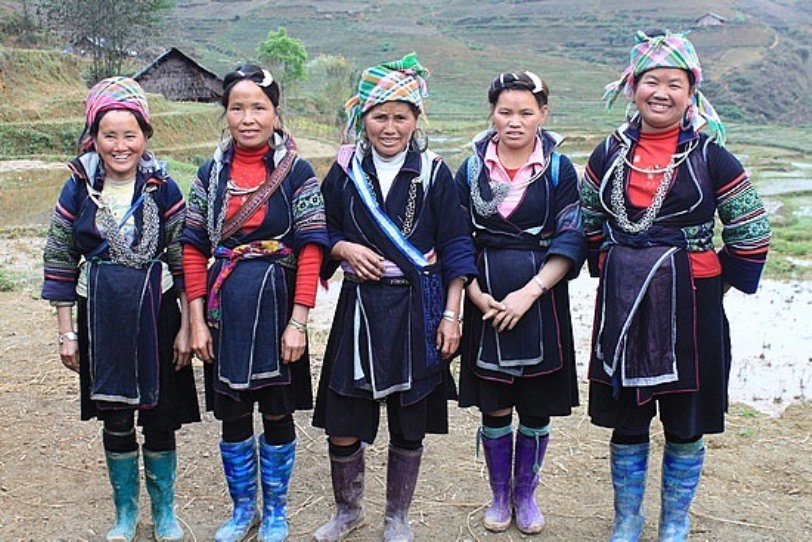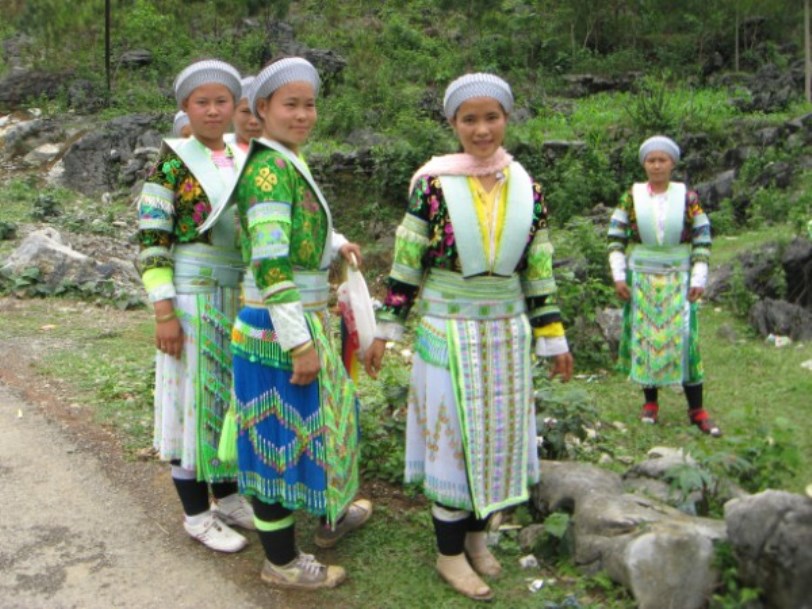Introduction
There are two kinds of H’Mong Minorities in Sapa and the most popular is Black H’Mong so you can visit the Black H’mong minority in, Ma Tra, Hau Thao, Y Ling Ho, Lao Chai and Cat Cat village. The second one is White H’Mong is in Nam Than, Nam Nhieu.
History & Languages
The H’mong immigrated from China approximately 300 years ago.The spoken language belongs to the H’mong – Dao language family. The H’mong writing was Romanized in 1961 but is not widely used today.
Beliefs
Many places are reserved for worshipping in a H’mong house – there’s a place for ancestors, for the house spirit, for the kitchen spirit, even the door spirit. There are different rituals which forbid people to walk into the H’mong house or their villages. For example, a green tree branch on the front door indicates that entrance is forbidden.
Costumes
The H’Mong women are famous for making cloth from hemp and dying it a deep indigo blue. They wear long blouses decorated with batik flowers over short trousers, and wrap long scarves around their legs. They wrap their long hair around their head and wear a blue turban. The men wear long jackets with shirts and a long waist coat embroidered at the collar, and a small hat. The most different of costumes between Black H’Mong and White H’Mong is the color that why it is easy to find them. If black color for whole costume is Black H’Mong people, if white and green color is White H’Mong. Today some H’Mong wear Viet or western clothes.

Social organization
H’Mong women are respected in their community as being equal with H’Mong men. Husbands and wives are very affectionate and do many of their tasks together like going to the market, working on the field and visiting relatives. In this way, they help each other to develop a strong community life.
Artistic activities
The H’Mong are very good at making agricultural tools, wooden furniture, musical instruments and jewelry. They are also famous for their handicraft and embroidery. They generally only make such items to meet their own needs, but other minorities in the area buy their produce because of its high quality. Since the advent of tourism in Sapa, many H’Mong women make decorated cloth to sell on the town’s main streets.
Festivals
Like the other minorities, the H’Mong have lots of different festivals during the year. They ensure that there is always time for community activities, which play an important role in their life. One of the most important festivals is the New Year, which they celebrate for an entire month. It happens about one month earlier than Vietnamese Tet. The second important festive of the year is “Gau Tao” after Tet Holiday in Spring. They pray to wish for a good harvesting time. During this time, boys play flutes and girls play an instrument made from two leaves. They all spend time together playing traditional games.

Marriage
For the Black H’Mong it is important that a girl knows how to embroider and work well in the field. These skills are more important than her beauty. Boys and girls are allowed to get to know each other before they get married. They go to the love market where they eat and sing songs together. After this time, the boy can propose marriage and if the girl agrees, she goes to live in his house. She is put in a small room and visited by the boy’s mother and sisters who give her food to persuade her to accept the marriage.
The boy must give the bride’s family silver coins, pigs, chicken and rice wine for the wedding ceremony. The bride has some time to decide if she accepts the marriage – even after living with her husband for a few days, she can choose to break their agreement. If the boy doesn’t have a dowry to give to the girl’s family, he lives in her house until he is able to marry her.
Funeral
When there is a death in the family, the deceased’s children fire a gun or drum to let everyone in the area know. People in the village come to deceased’s house with anything they have – chicken, rice, a small pig or rice wine – to help the family. Everybody sings and eats until the deceased is wrapped in a mat and carried to a grave by one group, while a coffin, which has been kept in a cave somewhere near the grave, is carried by another. Both groups have to run very fast to meet at the grave to make the deceased forget the way home. If the deceased’s family is not able to supervise the funeral rituals, they can wait for a few years before organising a special one called ma kho. They invite people in the village to a place by the grave for the funeral for a celebration, at which they sing and dance.